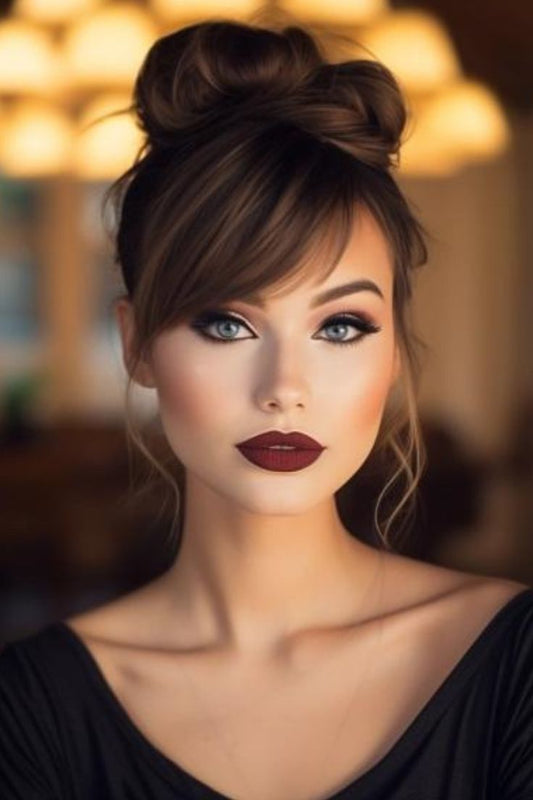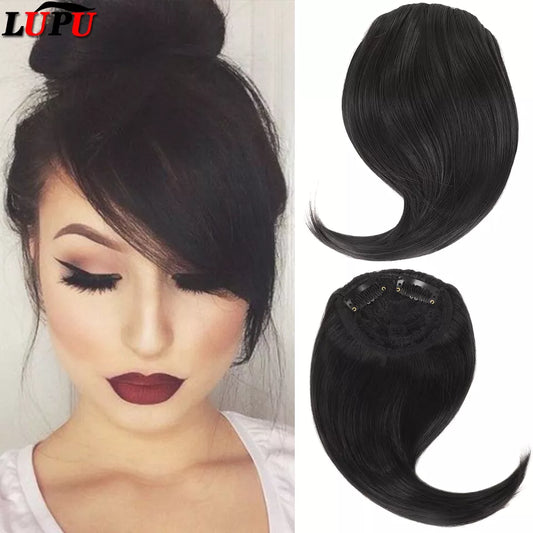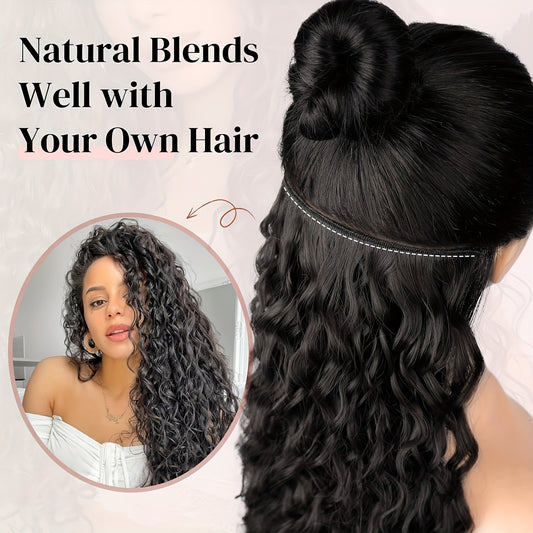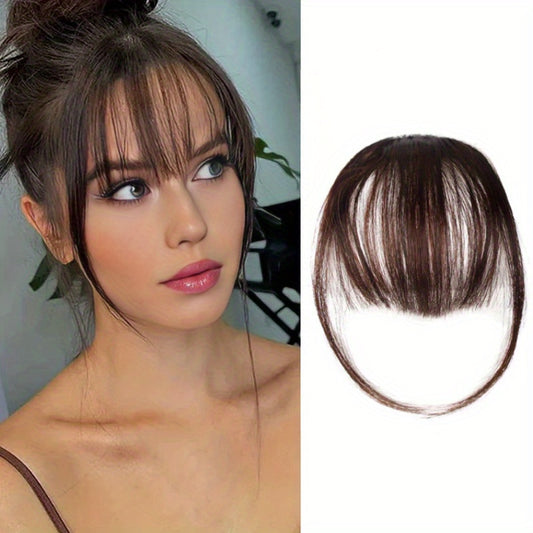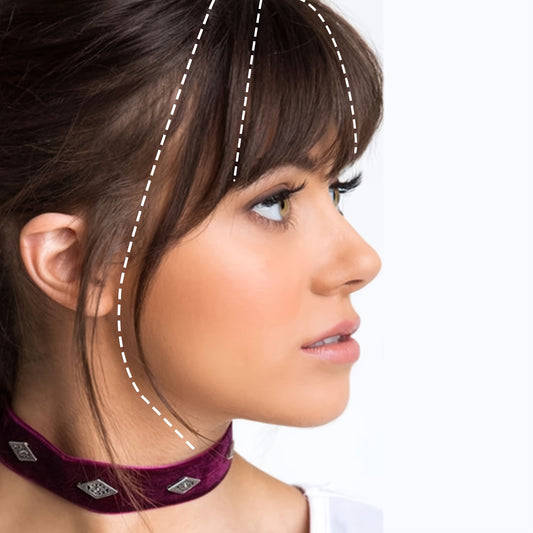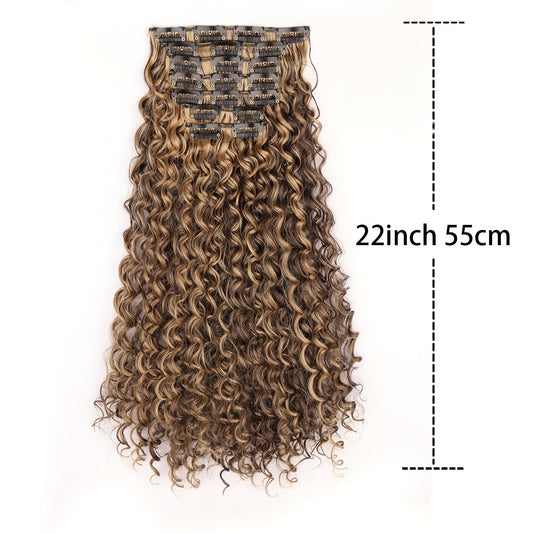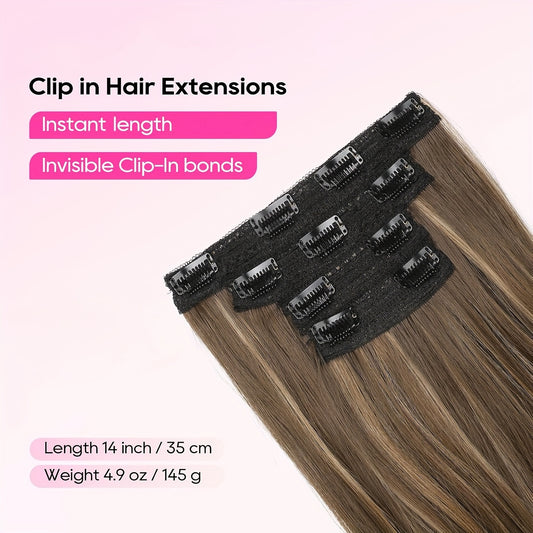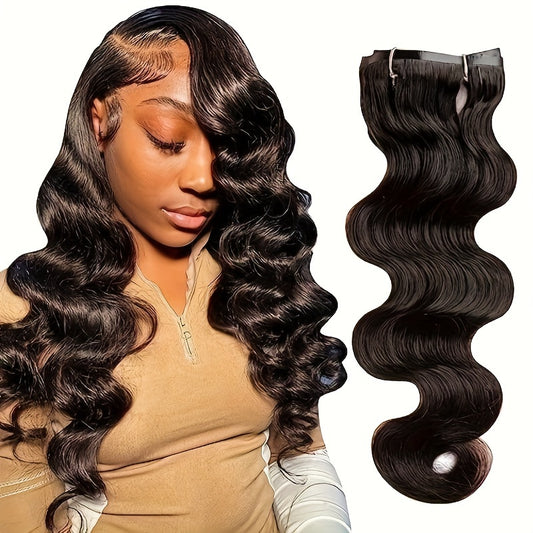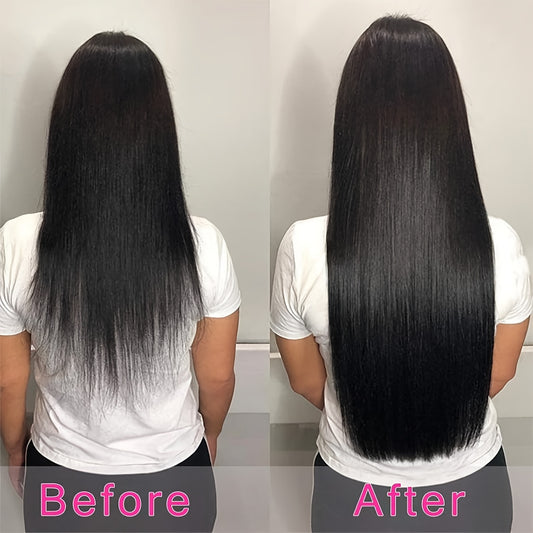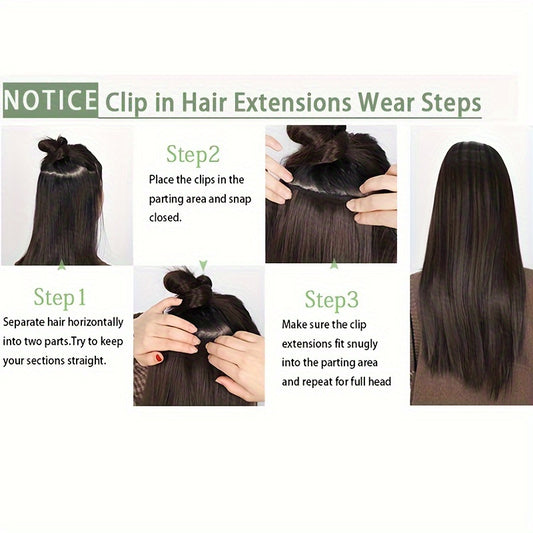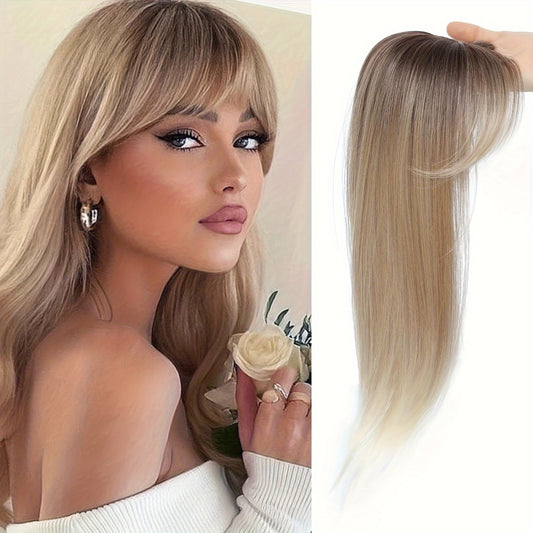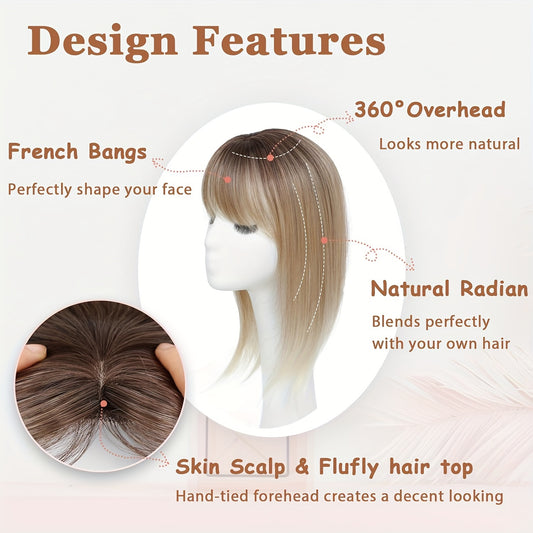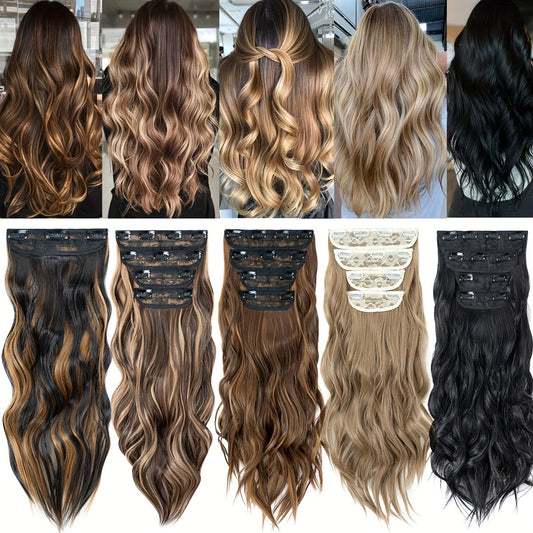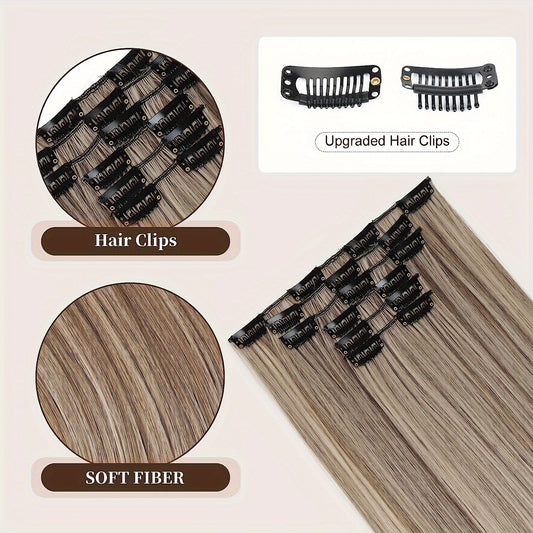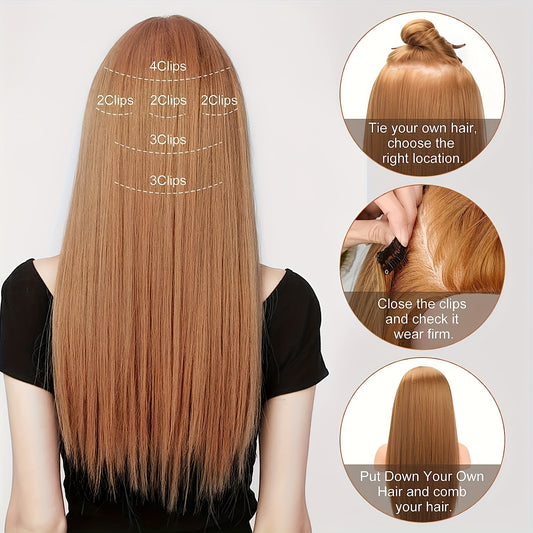About Black Hair Extensions
Shade overview
Black hair extensions sit at the deepest values of the shade scale and create a strong outline. Undertone may be neutral, cool, or softly warm depending on the fiber and finish. Because depth is high, small construction errors show; clean seams and a tidy hem matter.
Who this serves
Users who want a precise edge, minimal color work, and reliable contrast benefit most. Black pairs with monochrome wardrobes, structured blazers, and pared back makeup. It also protects natural hair by carrying most of the heat and styling load.
Formats at a glance
Clip in sets offer flexible density and fast changes. Tape in panels lie flat and spread weight over a wider area for longer wear between salon visits. Wefts support sew in and beaded row methods for structured installs. Seamless clip ins hide the top edge under finer hair. One piece volumizers add crown fullness in minutes.
Fiber quality and behavior
Human hair with aligned cuticles reduces frizz, reflects light evenly, and tolerates lower heat. High grade strands hold pattern after a full cool and allow clean micro trims at the ends. Mixed fibers can swing too shiny in some LEDs or too matte in daylight; human hair stays closer to natural optics.
Finish target
Aim for satin. Heavy gloss looks artificial; ultra matte reads dusty. One slow pass at low heat, a complete cool without touching, and a single brush to unify the panel produces a calm surface that photographs well.
Fabulive lists black extension lengths, grams, and formats with clear numbers so planning is straightforward.
Length by picture
Decide by landmarks, not numbers. On many frames, fourteen touches the collar, sixteen hits upper shoulder, eighteen meets mid shoulder, twenty crosses upper back, twenty two rests at mid back, and twenty four reaches lower back. Curves shorten the visual; straight reads longest.
Density planning
Weight lives at the base and acts like leverage at the neck. Many daily builds feel calm around ninety to one hundred twenty grams. Common fullness for everyday styling falls between one hundred twenty and one hundred fifty grams. Event builds can rise to one hundred sixty to two hundred grams if the base stays comfortable.
Undertone in real rooms
Neutral undertone stays steady across spaces. Cool undertones lean blue and look crisp near white walls and steel fixtures. Warm rooms can tilt a neutral toward brown in photos, while blue LEDs can make cool reads look icy. Check tone by a window first, then confirm where you actually work or film.
Textures and their behavior
Straight reads graphic and needs a clean micro bevel at the hem. Body wave adds movement that hides tiny join lines. Loose curls build volume without large gram increases. Coily textures look authentic when coil size mirrors your pattern and rows protect edge health.
Seams and coverage
Black shades emphasize gaps. Stagger clip widths so tops do not stack. Keep tape panels evenly spaced and avoid clear tabs that flash. For wefts, use even tension and neat fold backs so the row sits flat. Quiet seams sell the look better than extra product.
Format selection
Fabulive’s shade tiles show undertone in daylight from front and side angles, which speeds neutral or cool selection.
Pick clips for flexibility and fast removal. Choose tapes for flat panels and predictable salon cycles. Choose wefts when you want a stylist to build rows and shape structure. Any format can pass for natural when crown density and hem density agree.
Hem line integrity
Thin ends show quickly in black. If you wear straight, order slightly longer and plan a micro trim so the edge closes. If you prefer wave, a softer hem can still read intentional because motion hides the last few millimeters.
Mount height
High mounts show energy and expose the neck. Low mounts look sleek and protect edges. Mid mounts balance comfort with visibility. Higher positions add pull; lower positions can rub collars. Pick one height for the day and keep it.
Base preparation
Seat hardware on clean, fully dry roots. Brush in the wear direction. Keep oils away from attachment zones. For clips, create stable anchors. For tapes, ensure residue is gone. For wefts, braid uniformly or place beads at even intervals.
Mechanical checks
After install, do three tests: slow head turn to feel for slip, small jump to check tug, and jacket on off to see if seams shift. Fix mechanics first; finish comes after.
Heat and set discipline
Use low to medium heat. Shape with one slow pass, cool fully, then brush once. Avoid clamping heat across seams. For curls, hold in clips while cooling so a lower temperature keeps the pattern.
When inches must match outcomes, Fabulive provides simple length ladders and close hem shots so edge clarity is predictable.
Wash and dry
Wash when hair feels coated, not by calendar. Use cool water and a gentle shampoo. Keep bond areas dry if the method requires. Condition mid lengths to ends, rinse until clear, blot, and air dry on a hanger so the perimeter stays true.
Storage and rotation
Store clean, dry hair in a soft pouch away from heat and sun. Label length, grams, texture, undertone, and last trim date. Rotate lighter daily sets with heavier event sets to spread wear.
Travel routine
Choose compact patterns that pack well. Keep a small brush and two pins in a pouch. On long rides, coil hair forward to limit rubbing. In hotels, use a window and a pale surface opposite as a bounce for consistent color checks.
Friction control
Scarves, collars, backpacks, and rough straps create abrasion. Sweep hair forward before zipping, prefer smooth strap materials, and sit slightly forward to keep hems off chair backs.
Wardrobe planning
Black supports monochrome outfits and clean tailoring. White shirts lift contrast. Navy and charcoal keep a cool palette. Camel and tan can mute the edge; a white layer near the face restores separation. Silver and steel jewelry echo the tone.
Makeup alignment
For care basics, Fabulive posts a short wash routine and a do not soak the base reminder that fits real daily use.
Tidy brows, neutral contour, and cool leaning liners pair well. Day looks carry soft rose lips; evening looks carry berry or wine. Avoid orange bronzers at the hairline; they warm the frame under bulbs.
Lighting control
Pick one steady space for prep and photos. Daylight near a window is honest. Office LEDs vary; restaurant and stage lights skew warm. Clean the lens, lock white balance if your phone allows, and take a profile still before you post.
Creator workflow
Lock mount height, light angle, and lens distance for recurring shoots. Mark floor position with tape and save one reference image with exposure settings. Fixed inputs keep deep shades consistent across edits.
Workday pattern
Set mid height, select straight with a small bevel or body wave, and keep grams moderate. Avoid oils at the base. Pack a tiny brush and two pins. A short routine done the same way daily builds trust in the result.
Event pattern
Choose mid or high height based on neckline. Increase grams only if comfort remains. Polish with one slow pass and a complete cool. Run the jacket test before leaving and take a quick profile still under venue lights.
Edge and scalp comfort
Rotate mount heights across the week and keep tension firm but not tight. If edges feel stressed, lower grams or choose a lower mount for several days. Black outlines the hairline; calm edges improve the whole read.
If you need rooted options or specific textures, Fabulive’s product pages place root depth next to mid and end tones so the join is easy to picture.
Trim strategy
A micro trim after install joins ends to your cut and removes factory bluntness. For layers, mirror your template so movement lines meet cleanly. Even a small bevel changes how the silhouette reads in photos.
Quality checks on arrival
Confirm length, grams, and texture. Inspect seams for even stitching. Brush gently to shed loose cut ends. Photograph base and hem in daylight for records. If LEDs show odd shine bands, recheck in daylight before deciding on returns.
System over mood
Fix five inputs—height, grams, length, texture, undertone—and repeat them. Systems remove guesswork; the shade reads intentional and premium when variables stay steady.
Resource view
Extensions let you reach deep color without heavy dye cycles on your own hair. Lower heat and gentle wash routines extend life. Rotation delays replacement and reduces waste.
Seasonal behavior
Dry winter air raises static; mist water lightly before brushing. Summer humidity softens straight lines; body wave holds shape. In wet seasons, carry a soft pouch so you can coil hair forward between spaces.
Face shape mapping
Round faces benefit from body wave and a touch more length below the collar. Oval faces accept most patterns. Square faces soften with loose curl or longer bevels. Heart shapes balance with mid height and a line that passes the collarbone cleanly.
Salon teamwork
Bring room photos and wardrobe notes. Agree on gram targets and a trim plan. Ask for undertone guidance for your lights. Strong results come from shared engineering choices.
Exposure control basics
In phone capture, shadow detail holds the texture in black. If auto exposure brightens faces too much, hair can clip to flat black. Use exposure lock with a pale reference in frame, then step slightly off axis to soften glare without product.
Room and gear checklist
Headphones press along the head and can nudge seams if clamp force is high; pick mid height that clears ear cups. Lanyards and badges rub rows; route hair to the opposite side. Lavalier microphones near collars need a clear path to avoid noise.
Row spacing and geometry
Spacing interacts with head shape. Wider spacing increases swing but needs more density per row. Narrow spacing distributes movement and often feels lighter. Keep the lowest row above collar contact to reduce jacket friction.
Hydration and slip control
Hydration keeps the panel flexible, but oil near attachment points causes slip. Add leave in to mid lengths and ends only, and keep base areas dry. In dry air, mist water lightly before brushing to drop static without changing sheen.
Commuter method
Bikes prefer mid mounts and compact wave to resist lift. On trains, coil hair forward against coats and release before exiting. In ride shares, sit slightly forward so seat belts do not rub the hem for long stretches.
Wardrobe contrast matrix
Optical white gives maximum edge clarity. Soft white narrows contrast for a gentler read. Cool grey echoes undertone and looks precise. Camel and tan reduce separation; a white layer near the face restores contrast when you choose warm fabrics.
Long term storage
Detangle dry, braid loosely, cushion with acid free tissue, and store flat in a breathable pouch. Avoid vacuum sealing which can crease seams. Label pouches with length, grams, texture, undertone, and last trim date for fast redeployments.
Optical separation
If background and hair are both dark, step forward by half a meter and turn three degrees from square. The small shift creates a rim of light that separates the outline without sprays or filters.
Chair and collar choreography
Blazers, hoodies, and tall chair backs press on the same zones. Before long sits, sweep hair forward over one shoulder, then return it after you stand. For hoodies, rest the hem above the collar to prevent fleece scuffing.
Smartphone setup
Disable auto enhancements, wipe the lens, and lock exposure. Clean optics and steady settings preserve black texture that software smoothing would flatten.
Silhouette planning
Balance hair shape with clothing. Strong-shoulder jackets pair well with straight hems; draped outfits benefit from wave for motion. Treat silhouette as a single design rather than two separate pieces.
Row curvature
Occipital depth varies. If your head is flatter at the back, curve rows a touch tighter so pieces follow the skull and do not lift at corners during motion.
Elevator check
Use elevator mirrors to scan side seams and hem level. If you see a shelf at the parietal area, reseat the top pieces at your next stop instead of adding product.
Static control
Synthetics and dry air lift flyaways. Mist water lightly before brushing and let the panel settle for thirty seconds before moving. Optics stay cleaner when the surface is quiet.
Color drift over day
Morning daylight runs cooler; late afternoon runs warmer. If your feed spans both, standardize to one time or reuse a white balance lock so the shade does not appear to change.
Glare fixes
Move the light higher and a bit to the side instead of spraying mattifiers. Deep colors look premium when you solve light position rather than piling on coatings.
Wind recovery
After wind, step indoors, detangle from ends to mid, re-press seams, and do a single wide tooth pass. Skip heat; the set returns as hair equalizes to room humidity.
Badge routing
Clip badges low or to the opposite shoulder so the lanyard does not saw across seams when you turn. Small routing choices protect the base more than product layers.
Hat coordination
Low beanies compress seams; choose a looser knit and mid mount. For caps, route bulk through the opening and keep the hem above jacket collars so pressure does not stack.
Optics first
When something looks wrong, change room, angle, or distance before changing hair. In dark shades, most problems are light problems, not hair problems.
Note card method
Write mount height, grams, length, texture, and undertone on a small card and store it with the set. Update only when a change proves better across three days. The card keeps results consistent when schedules get busy.
New set onboarding
When a new set arrives, take a daylight still of ends and base, then a mixed light still in your main room. Keep both as references for future checks and reorders.
Install ergonomics
Sit with forearms supported so you do not over tighten at the crown. Lower strain produces better placement because precision lasts longer.
Hair health crossover
Let extensions carry heat so your own lengths rest. Track breakage and growth monthly. If roots improve, keep the routine; if not, lower heat further or reduce wear on off days.
Travel day kit
Carry a soft pouch, small brush, two pins, a gentle cleanser decant, and your settings card. With these, you can reset optics in any hotel bathroom.
Storage rotation
If an event set sits for months, detangle, braid loosely, add tissue, and store flat. Write the storage date and target recheck month on the label so you do not forget adjustments.
Phone model variance
Different phones render blacks differently. Test on your device and a friend’s. If tones drift, publish from one phone for consistency.
Crosswind handling
In open areas, sweep hair to the upwind side so it settles along your body rather than across your face. A single hidden pin under the wrap prevents base rotation.
Keyboard posture
If chair backs hit mid back, bring hair forward during long typing periods. Preventing scuffing is faster than fixing dull patches later.
Neckline pairing
Mock necks and high collars pair with mid or low mounts so fabric and base do not fight for the same space along the nape.
Video motion settings
Use a higher frame rate for smooth hair motion. Stand slightly off axis to your key light so reflections travel gently across the surface.
Meeting to dinner switch
Set mid height and body wave for the day. Before evening, verify hem, brush once after full cool, and take a quick profile still. The base stays the same while polish increases.
Lens cleanliness
Wipe the lens before every photo. Fingerprints flatten detail and make deep colors look muddy. Clean optics protect good work.
Collar science
Sharp point collars can catch hems; rounded collars glide under longer lengths. Match collar shapes to mount height to avoid friction.
Skip list
Skip oils at roots, skip stacking sprays to hide mechanics, and skip last minute heat passes on already set panels. Skipping keeps surfaces clean and durable.
Calibration recap
Lock five inputs—mount height, grams, length, texture, undertone—then prepare in the same room. Take one profile still before leaving. If seams read, adjust placement instead of adding product. Consistency in a few small moves keeps black reading intentional without extra effort.
Content calendar alignment
Assign looks to recurring days—straight with bevel for Monday, body wave midweek, structured builds on Fridays—so your grid has rhythm without extra decisions.
Workday timeline planning
Prepare at a fixed time in the same light with the same order. Routine turns good results into reliable ones across busy weeks.
Event timeline planning
Sequence install, cool, brush, still, wardrobe, and transit. Cooling time prevents rush gloss that looks artificial under LEDs.
Side profile discipline
Side angles reveal most seams. If any top line prints, adjust clip angles or panel spacing until profiles read clean.
Back view verification
Use a second mirror or quick phone still to spot stacked seams, gaps, or uneven hems. Correcting the back view improves how the front reads in motion.
Contrast with complexion
Balance hem geometry and mount height so the frame supports skin tone. Strong edges help fair skin pop; soft wave can flatter stronger jawlines.
Undertone harmony
Neutral undertones travel between rooms; cool undertones sharpen whites. Decide using daylight plus your main work light, not one source alone.
Root illusion tactics
If roots are slightly lighter or warmer, choose a wrap strand half a step deeper than the tail to create natural shadow at the base.
Blend with natural density
Match end fullness to your crown density so the head reads as one. Fine crowns pair with lighter grams and wave; dense crowns support straight and higher grams.
Common error corrections
Gaps at the crown need a narrow piece or a part shift. Thin straight hems need a tiny trim or grams. Over-shine needs angle changes; under-shine needs soft side light.
Risk mitigation
If a seam lifts, stop and fix rather than adding spray. If light skews tone, change position or background before changing hair—optics first.
Sustainability notes
Gentle wash cycles, air drying, lower heat, and rotation extend life and reduce waste. Planning grams wisely avoids over-building sets.
Replacement planning
Track wear counts, rinses, and trims to predict when performance drops. Replacing on schedule keeps your silhouette and undertone continuous.
Labeling taxonomy
Adopt a short code for height, grams, length, texture, and undertone so notes with your stylist remain clear and fast.
Storage architecture
Use breathable pouches with supports so seams do not crease. Label each pouch with length, grams, texture, undertone, and last trim date.
Shears and trimming safety
Trim on dry hair with purpose built shears and micro cuts. Align elbows to maintain bevel symmetry and avoid pale scrape marks.
Brush and comb selection
Wide tooth combs detangle without tearing patterns; soft cushion brushes finish the surface. Keep stiff bristles away from seams to prevent lift.
Heat tool specs
Use ceramic tools with accurate thermostats in low to medium ranges. Avoid clamping over seams and always allow full cooling before brushing.
Weather contingencies
Carry a soft scrunchie for wind or rain. Coil forward during transit, then release and brush once indoors to restore the surface.
Exercise considerations
Lower grams or braid loosely for movement days. Remove pieces for high intensity sessions or reset placement afterward to protect seams.
Outerwear compatibility
Run a profile still in your jacket at home. If mounts rub, lower height by one notch or route hair forward before you leave.
Fabric friction index
Wool and heavy canvas scuff faster than cotton poplin or smooth synthetics. Choose smoother straps and sweep hair forward before zipping coats.
Sound and hair interference
Route hair away from lav mics and badge cables. Rubbing creates harsh noise that audiences read as unpolished even when hair looks fine.
Video framing notes
Keep lens at eye level, camera an arm’s length away, and hair a hand’s width off the background so outlines remain clear on small screens.
Photo audit routine
Keep reference stills labeled by room and settings. Match new frames to the reference before changing hair choices; most issues in dark shades are optical, not mechanical.
Daily reset checklist
Detangle, check base, shape with one pass, cool completely, brush once. Midday jacket test. Evening coil forward for transit. A short checklist beats last minute product stacking.
Travel kit contents
Carry a small brush, two crossed pins, a soft pouch, and a gentle cleanser decant. Add a labeled settings card with mount height, grams, length, texture, and undertone.
Hardware upkeep
Replace bent clip teeth, lifted tape edges, and loose stitches early. Small, early fixes stay invisible; late fixes alter the silhouette.
Weft row placement
Place the lowest row above collar contact and mirror head curvature to avoid side gaps. End each row with neat fold backs that lie flat so cameras do not catch micro shadows.
Tape panel staggering
Offset tapes vertically by a small margin to avoid a single visible shelf. Keep adhesive away from oils during install and at least a finger’s width from the hairline.
Clip orientation choices
Angle clip teeth slightly downward so they bite into the base. If a section rotates, reseat with a shallower angle and retest with a head turn.
Section width logic
Narrow pieces curve with the head and vanish under finer hair. Wider pieces speed coverage but require careful staggering to avoid a visible strip along the top.
Parting strategy
Micro-shift the part so seams remain below sight lines and root lift refreshes without heat. Keep the top product-light so parts do not glare on camera.
Mount mapping
Note which collars, headphones, or hats collide with each mount height. Use the map when dressing so fabric and hardware never fight during the day.
Gram budgeting
Set a comfort zone and a ceiling. Many heads feel calm near ninety to one hundred twenty grams daily, with event ceilings under one hundred sixty unless the base is very compact.
Length decision framework
Pick a picture target—collar, shoulder, mid back—then map inches to that picture. Write the number on a small card so you stop re-deciding with every order.
Hem polishing methods
Film a slow pan of the last two inches in daylight. If light passes through the very edge in straight styles, trim millimeters or add grams so the outline closes.
Coily definition workflow
Define clumps with water first and a light leave-in on mid to ends. Diffuse on low as needed, keeping tools off seams so spring remains protected.
Wave setting workflow
Use a medium barrel, wrap away from the face, clip to cool, then brush with a wide tooth comb to form an S curve that hides small line mismatches.
Straight finish workflow
Dry fully, make one low heat pass, allow a complete cool, then brush once and add a micro bevel. More passes create shine bands that phones exaggerate.
Curl integrity management
Let curls cool completely in clips, then separate with fingers. On humid days, choose a slightly tighter set so the pattern relaxes into the intended shape as the air works on it.
Detangling protocol
Support sections with your other hand, comb from ends upward with a wide tooth comb, then finish with a soft brush to unify the panel without pulling at the base.
Scalp care cycle
Match cleaning to your own oil production. Clarify roots lightly if attachment zones feel slick and keep conditioners on mid to ends so anchors remain stable.
Panel topology design
Build from the nape upward using narrower pieces low and wider pieces through the parietal area. Stagger tops to avoid a single horizontal shelf and leave room near the hairline for natural lift.
Row tension control
Even tension prevents hotspots. If one point pinches after a few minutes, reseat that panel or redistribute pressure so blood flow stays calm around attachment points.
Edge line treatment
Decide on a tight or soft frame. For a tight read, smooth the hairline lightly with water and brush upward. For softness, leave a few temple wisps and tuck them behind the ear after install so edges look intentional.
White balance reference
Use a doorframe or simple card as a reference, lock white balance once, and reuse it. This removes day-to-day drift that would otherwise change how black appears across posts.
Shadow management
Black needs form, not voids. Keep a soft side light so the perimeter shows a gentle gradient. If the background is dark, step away from the wall to create a thin light rim that separates the outline without sprays.
Lighting variance across spaces
Office corridors, elevators, and open desks all push different color temperatures. Test a still in each space and choose one home base with predictable light; use that base for preparation so the shade reads consistent across days.
Comfort diagnostics
If the setup disappears from awareness, it is right. If you notice tugging, rotate mount height or lower grams. Comfort signals realism more than extra polish.
Visual language of black
Deep shades communicate intention. Shapes look precise and errors stand out. Treat the finish like tailoring: measured sheen, even lines, and calm motion.
Room repeatability
Use the same corner daily: neutral wall, window light, and a simple bounce surface opposite. With a fixed spot, results stop drifting and checks get faster.
Optics checklist
Clean lens, lock white balance, choose one room, take a profile still, verify seams are quiet, post only when the line reads deliberate.
Customer reviews
- Depth looks rich without plastic shine; a single low heat pass and full cool kept the surface calm through a long commute. — Ava Mitchell, USA ⭐⭐⭐⭐⭐
- 18 inches lands mid shoulder for me and blended after a tiny trim. — Oliver Hughes, United Kingdom ⭐⭐⭐⭐⭐
- I shoot under mixed LEDs at work; locking white balance steadied the shade and the finish reads satin on camera. — Mia Thompson, Australia ⭐⭐⭐⭐⭐
- Conference week: mid height, body wave, moderate grams. It stayed secure and I stopped thinking about it by lunch. — Noah Carter, Canada ⭐⭐⭐⭐⭐
- Movement is clean and seams stay quiet in profile stills; the hem reads deliberate after a micro bevel. — Sofia Romano, Italy ⭐⭐⭐⭐⭐
- Overall quality is solid; courier delay means four stars, but the blend under office light is excellent after one rinse. — Felix Bauer, Germany ⭐⭐⭐⭐
- On video calls, part lines did not flash even during turns; staggering clip widths really helped. — Chloé Bernard, France ⭐⭐⭐⭐⭐
- Two trains and wind off the river later, the base never rotated; the jacket test paid off. — Liam de Vries, Netherlands ⭐⭐⭐⭐⭐
- First time choosing this shade; the small settings card made mornings a two minute routine. — Aria Sato, Japan ⭐⭐⭐⭐⭐
- Great hair; I would only widen the pickup window. The edge line feels polished after a micro trim. — Daniel Meier, Switzerland ⭐⭐⭐⭐

